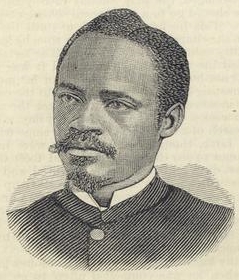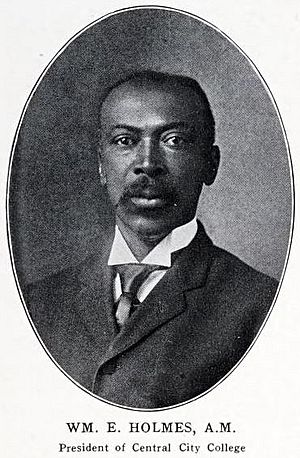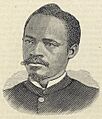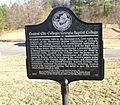Georgia Baptist College facts for kids
|
Former name
|
Central City College (1899–1938) |
|---|---|
| Type | Private HBCU |
| Active | October 1899–1956 |
|
Religious affiliation
|
Baptist |
| Location |
,
United States
|
| Campus | 235 acres (95 ha) |
Georgia Baptist College was a private school and college located in Macon, Georgia, in the United States. It was first started in 1899 and was known as Central City College. Later, in 1938, its name was changed. The school had to close its doors in 1956 because it ran into money problems.
The idea for this school came about in the 1890s. Some African American Baptists in Georgia disagreed with a group called the American Baptist Home Mission Society (ABHMS). This group was connected to the Atlanta Baptist Seminary, which is now Morehouse College. The African American Baptists felt that Atlanta Baptist should have more African American leaders. So, in 1899, Central City College was created as a new school led by African Americans. A well-known Baptist preacher named Emanuel K. Love helped start it. William E. Holmes, who used to teach at Atlanta Baptist, became its first president.
For its first few decades, the school mainly taught younger students in primary and secondary grades. It added a college program in 1920. In 1921, a fire badly damaged the school, but it was rebuilt. The school struggled with money for most of its history. In 1937, it faced foreclosure, meaning it was taken over because of unpaid debts. Even though it kept going for a few more years, it finally closed in 1956.
Contents
Why the School Started

The idea for Central City College began in the 1890s because of disagreements among African American Baptists in Georgia. At that time, the American Baptist Home Mission Society (ABHMS) was a powerful group that supported many African American Baptist schools, including the Atlanta Baptist Seminary. However, many African American Baptists felt that white leaders from ABHMS had too much control over these schools.
The Reverend Emanuel K. Love, a respected Baptist leader from Savannah, Georgia, strongly believed that African Americans should have more leadership roles in Baptist schools. He had tried to join the leadership boards at Atlanta Baptist and Spelman Seminary but wasn't successful. To ease the tension, ABHMS agreed in 1897 to work with African Americans to get more representation on school boards. But even after Atlanta Baptist became a college that same year, African Americans were still mostly left out of leadership. So, in 1899, Love announced that a new African American Baptist college would be formed to compete with Atlanta Baptist.
Love, working with the Missionary Baptist Convention of Georgia, bought about 235 acres (95 ha) of land near Macon, Georgia for the new college. In September 1899, the school offered the president's job to William E. Holmes, an African American teacher from Atlanta Baptist. Holmes had been the first African American teacher at Atlanta Baptist and had worked there for over 20 years. He first decided to stay at Atlanta Baptist. But he changed his mind and joined Love after the president of Atlanta Baptist asked him to speak out against the new school. Holmes had previously tried to remove the Atlanta Baptist president from his job. This might have influenced his decision to lead the new school.
John Hope, a friend and fellow teacher at Atlanta Baptist, chose to stay in Atlanta. He became the only African American teacher there at the time. Later, in 1906, he became Atlanta Baptist's first African American president. Many students also chose to stay at Atlanta Baptist instead of moving to the new school.
How Central City College Began

The new school, called Central City College, officially opened in October 1899. It was part of a trend in the late 1800s and early 1900s where independent Baptist colleges were started to serve African Americans in the American South. Other similar schools included Guadalupe College and Morris College.
At first, Central City College mainly taught younger students. It had a primary school, a high school, and a three-year program for studying theology (religious studies). Both boys and girls could attend, but only men could join the theology program. Only a few students took part in the theology program.
From the start, the school aimed to follow the teaching style of liberal arts colleges in New England. This was different from the "industrial education" approach favored by Booker T. Washington, a famous African American leader. The primary school offered subjects like geometry, grammar, history, math, penmanship, and reading. The high school included more history, advanced math, bookkeeping, physiology, physics, and languages like English, Greek, and Latin. Only two teachers had college degrees: Holmes and Reverend James M. Nabrit, who had a bachelor's degree from Atlanta Baptist.
Early Years and Challenges
By its third year, Central City College had 365 students. By 1908, it had 11 teachers and 325 students. The school faced financial difficulties for most of its existence. One historian, Willard Range, wrote that it "remained perpetually on the verge of bankruptcy and closure."
In 1908, the school's yearly operating costs were about $4,000. Records from 1916 show that the school collected only $307 in school fees, which was about $5 per student. The Missionary Baptist Association provided some financial help. The school also used some of its large campus for farming. By 1908, about 100 acres (40 ha) of the school's 325 acres (132 ha) campus was used as farmland.
Government Report
In 1914, officials from the United States Office of Education visited the school. They were gathering information on African American education across the country. Their report noted that Central City College had 40 primary school students and 25 high school students, though numbers were usually higher in winter. Four full-time teachers and two volunteer teachers taught these students.
The report estimated the school's property, buildings, and materials were worth about $16,000. It also noted the school was $5,000 in debt, mostly from unpaid salaries and other costs. The report concluded that Central City College was "of slight educational value to the community" and suggested that "the plant be sold and the work transferred to some of the stronger Baptist schools of the State."
Later Years and Closure
In 1920, the school officially started its college department, and the number of teachers grew to eight. However, in May 1921, a fire destroyed Central City College's buildings. According to President Holmes, the fire, started by someone accused of insanity, ruined most of the school's buildings and "nearly everything else we had."
After the fire, local farmers sold some of their produce to raise money for rebuilding, collecting about $164. The Reverend T. J. Goodall, a board member, personally donated $50. For the fall semester that year, 204 students enrolled, and classes were held in tents on campus. Most students traveled from home, while 43 lived on campus, staying in the president's house or in tents. Fundraising efforts continued until at least 1923.
Around Christmas 1921, President Holmes was visited by John Hope (who was now president of Morehouse College), E. C. Sage from the General Education Board (GEB), and Reverend M. W. Reddick. They discussed the school's future. They felt the school was "poorly managed" but were interested in making it a good secondary school connected to the Morehouse system.
In 1924, Holmes retired as president. He was replaced by Reverend J. H. Gadson. Gadson asked the GEB for financial help and even suggested the school focus more on industrial education for high school students. However, the GEB did not provide funding.
In late 1933, Gadson started a big fundraising campaign to improve the school. He wanted it to be as respected as Atlanta University. During a trip to New York City, he got donations from the National Baptist Convention. He also gave his entire year's salary of $1,800 to the effort. People in Macon and Baptist groups across the state also contributed. James H. Porter, a local businessman and helper, who led Central City's white advisory board, donated $5,000.
However, just a few years later, in 1937, the school faced foreclosure. James H. Porter took ownership and put the school under the control of the Georgia Baptist Missionary and Educational Convention. The next year, the school was renamed Georgia Baptist College. The school continued to operate and raise money, even holding musical events for segregated audiences. During this time, the well-known theologian J. Deotis Roberts taught at the school and was its Dean of Religion for one year. But the school never fully recovered financially and finally closed in 1956.
What Central City College Left Behind
In a 1975 book, historian James M. McPherson wrote that Central City College, which was celebrated as a great effort in self-help, soon became a small secondary school and eventually closed. Willard Range, in a 1951 book about historically black colleges and universities in Georgia, said the school was created "in the spirit of antagonism." This meant it lacked widespread support and had to "fight for its existence," while its higher education efforts remained "petty and pitiful." In 2003, the Georgia Historical Society placed a Georgia historical marker in Macon to honor the school.
Images for kids
-
The Reverend Emanuel K. Love helped a lot in starting Central City College.
-
William E. Holmes was the first president of Central City College.





